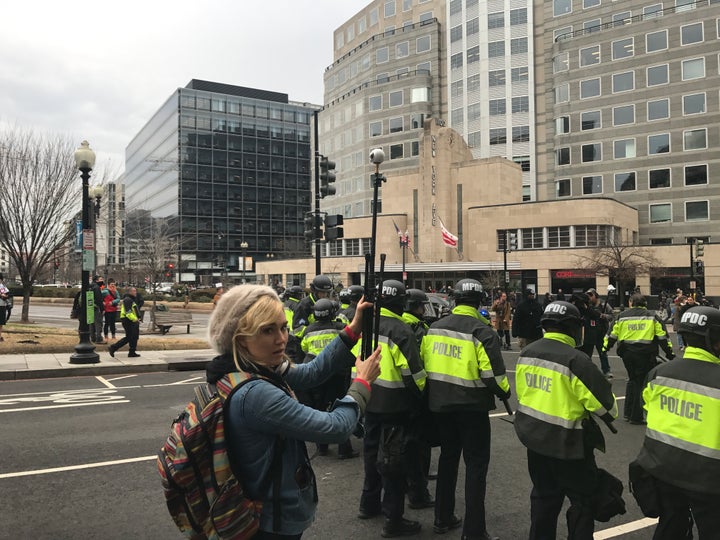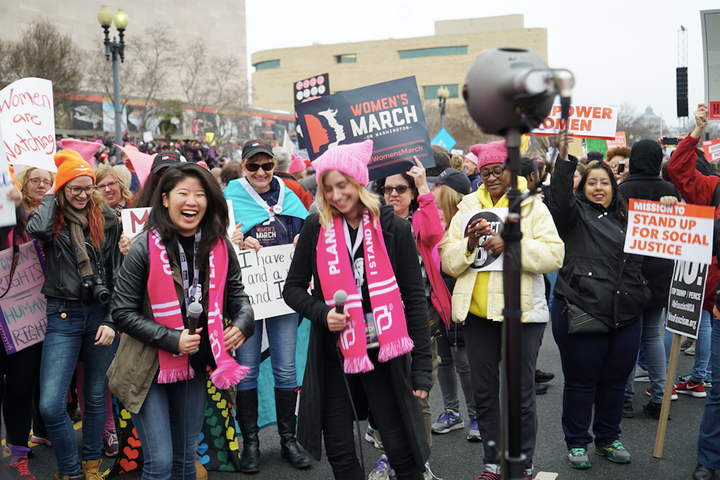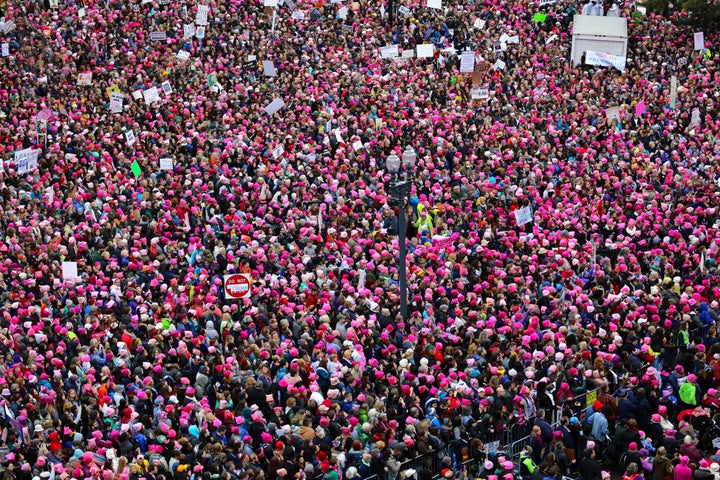
RYOT’s Nora Kirkpatrick holds a Samsung Gear360 camera over the heads of riot police on Inauguration Day, Washington D.C.
On my flight to Washington D.C. last week, I sat two rows away from a woman proudly sporting a ‘Hillary For Prison’ hat. I live in Los Angeles, so even though I’d seen photos of that kind of apparel at Trump rallies on the news, the mere proximity to a real, live human female who not only voted against Hillary, but believes she should be incarcerated, was novel, even thrilling in a way. I arrived hours later at my Airbnb in Northwest D.C., and was greeted by my team with hugs and my own headwear ― a freshly sewn, pink pussy hat, in anticipation of the Women’s March on Washington.
The personal desire to be a part of the historic moment was why we were there, but we also had three virtual reality assignments: to capture footage for our Hulu news series (The Big Picture: News in Virtual Reality), to report breaking news in stereoscopic VR for Google, and also to produce RYOT & The Huffington Post’s first ever VR livestream during Saturday’s protest.
Our coverage strategy intentionally mirrored the Women’s March as a moment in time. We had a diverse, multi-lingual, all female crew, using VR camera technology to include people, in real time, at the D.C. event from anywhere in the world and to broadcast the march in live VR for Facebook, the same platform that kicked off the movement when a Hawaii grandmother’s wall post went viral.
For this unprecedented weekend in D.C., VR was our tool, and we were incredibly excited about using live VR for the first time. We were even more thrilled when we realized that our two live streams had gotten nearly 1 million views in the first 12 hours.

RYOT kicks off the Facebook VR live stream of the Women’s March in D.C. with the Nokia OZO.
But the true significance of the moment was somewhat lost in the logistics and metrics, until I sat down to write this and saw the full picture: We were the first all female crew to execute a virtual reality livestream, ever, at not only the largest women’s march of all time, but the largest nationwide protest in American history.
RYOT’s name actually comes from the Martin Luther King Jr. quote, “A riot is the language of the unheard,” and the company was born in seeing an opportunity for technology to be a force that connects us, and has the power to ignite change.
This is part of why leaning into emerging technology like VR made sense for us. We were one of the first companies in the world to use 360/VR filmmaking technology in service of journalism, making VR films for the New York Times, The Associated Press, NPR, and The Huffington Post before being acquired in April by AOL.
I’ve seen people cry and make huge donations on the spot after watching VR films. But for breaking news coverage like this, it’s more about creating an authentic sense of presence. Once you do that, reality does the rest of the work. In some ways, live VR is the most vérité filmmaking there is, because the viewer is in control. If I’d had live VR capabilities 24 hours earlier than we did, during the clashes on Inauguration Day, undoubtedly viewers would have flinched and ducked, heart pounding as fight or flight instincts kicked in, the way I did when concussion grenades thrown by riot police exploded mere feet away from me.
There in the street, we chased after the action, almost instinctually. For as long as there has been news, people have tried every which way to get closer to the story. Per the laws of supply and demand, journalists have gained better and better access ― yes, to serve the truth, but also to serve the public’s appetite for this kind of information.
Before literacy was widespread, there were town criers, ringing hand bells to get attention and draw a crowd. Newspapers started to print photography, radio came into our cars, TVs into living rooms with networks racing to reach 24 hours of broadcast. Now, a few decades later, the all the news in the world is digitized and lives in our pockets and purses, and we have fully immersive technology to watch news as though you were standing halfway across the world, in food lines at refugee camps, or on the National Mall in D.C. for an unforgettable moment in the fight for equal rights.
Why do we crave this? Because there is no substitute for being there. It’s why VR will never truly cannibalize live experiences. It’s why President Trump’s Press Secretary’s first words on the White House podium were telling us (falsely) that more people attended this inauguration than any before. And of course, it’s why Saturday’s turnout of nearly 5 million people across the globe is significant. Presence at this scale is not only symbolic to the world watching, but incomparably significant to every single person who experienced it.
Presence is powerful, because it is an antidote to apathy. Purpose is a basic human necessity, and you won’t find it unless you show up.

A sea of pink on Independence Avenue, Washington D.C.
Keep the momentum going by signing up for 10 Actions /100 Days.
